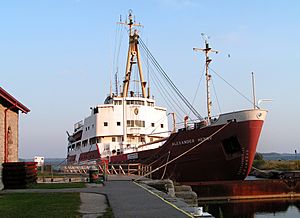CCGS Alexander Henry facts for kids

CCGS Alexander Henry in retirement as a museum ship in Kingston.
|
|
Quick facts for kids History |
|
|---|---|
| Name | Alexander Henry |
| Namesake | Alexander Henry |
| Operator |
|
| Builder | Port Arthur Shipbuilding Co. Ltd., Port Arthur |
| Cost | $2,259,750.00 |
| Launched | 18 July 1958 |
| Christened | 18 July 1958 |
| In service | July 1959 |
| Out of service | 1985 |
| Identification | IMO number: 5010062 |
| Status | Museum ship since 1986 |
| General characteristics | |
| Type | Light icebreaker and supply and buoy tender |
| Tonnage | 1,674 GRT |
| Displacement | 2,497 long tons (2,537 t) |
| Length |
|
| Beam | 13.3 m (43 ft 8 in) |
| Draught | 4.9 m (16.08 ft) |
| Installed power | 3,550 bhp (2,650 kW) |
| Propulsion | 2 × Fairbanks-Morse 10-cylinder 2-cycle diesel model 37F16 |
| Speed | 13 knots (24 km/h) |
The CCGS Alexander Henry was a special ship that worked for the Canadian Coast Guard. It was a light icebreaker and a buoy tender. This means it helped break ice in the water and placed or moved floating markers called buoys. The ship served on the Great Lakes from 1959 to 1984.
In 1986, the ship became a museum ship in Kingston, Ontario. It was looked after by the Marine Museum of the Great Lakes. For a while, you could even stay on the ship like a bed and breakfast during the summer! In 2017, the Alexander Henry was sold to the Lakehead Transportation Museum Society in Thunder Bay, Ontario. It moved there in June and is still a museum ship today.
Ship Design and Features
The Alexander Henry was built to be a light icebreaker and buoy tender. It was made specifically for working on the Great Lakes. The ship was 64.0 metres (210 ft 0 in) long from end to end. It was also 13.3 metres (43 ft 8 in) wide.
The ship weighed about 2,497 long tons (2,537 t). It had two powerful Fairbanks-Morse diesel engines. These engines gave the ship 3,550 brake horsepower (2,650 kW) of power. This power allowed the ship to reach a top speed of 13 knots (24 km/h; 15 mph). The ship did not have a special landing spot for helicopters. This was because helicopters were not thought to be needed for freshwater operations.
Working on the Great Lakes
The Alexander Henry was built by the Port Arthur Shipbuilding Co. Ltd. in Port Arthur, Ontario. It was launched into the water on July 18, 1958. The ship started its work in July 1959. It was first part of the Department of Transport's Marine Service. Its name came from Alexander Henry the elder, who was an explorer and fur trader in the 1700s.
In 1962, the ship joined the new Canadian Coast Guard. It was then called CCGS Alexander Henry. The ship spent its whole career on the Great Lakes. It was mainly stationed on Lake Superior.
In 1976, the ship was part of an interesting experiment. They tried using a hover platform pushed in front of the ship to break ice. It worked well in some conditions. However, it used too much fuel and was very noisy. The platform also caused problems if it broke down. This idea was not used for cargo ships. But the experiment did help lead to modern self-propelled hovercrafts that break ice today. The Alexander Henry stopped working in 1985. This was after a new ship, the CCGS Samuel Risley, started service.
Becoming a Museum Ship
In June 1985, the Alexander Henry was given to the Marine Museum of the Great Lakes. This museum is in Kingston, Ontario. The ship became a museum ship. It was used as a floating gallery about maritime history. It also served as a seasonal bed and breakfast.
In 2010, the Alexander Henry went into drydock in Kingston. This was for an inspection to check its condition. In 2016, the museum had to move from its building. This meant they needed a new home for the Alexander Henry. The ship was temporarily kept by a local person. The city of Kingston looked at different options for the ship's future.
One option was to sell the ship to Thunder Bay. This is where the ship was originally built. This was the cheapest choice. Turning the ship into an artificial reef would cost over $422,000. Scrapping the ship would cost $326,000.
The Lakehead Transportation Museum Society bought the ship for just $2! On April 11, 2017, they received $125,000 from the City of Thunder Bay. This money helped pay for towing the ship from Kingston to Thunder Bay. The Alexander Henry left Kingston on June 20. It arrived in Thunder Bay on June 28. The ship was first docked at the C.N. Ore Dock. Later, it moved to its permanent spot at the Pool 6 site along the city's waterfront. The museum ship opened for public tours on July 18.

